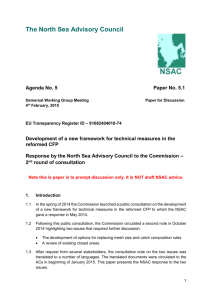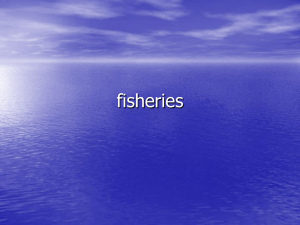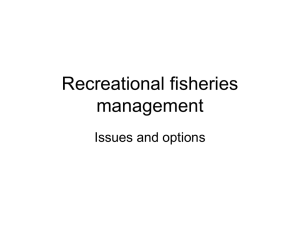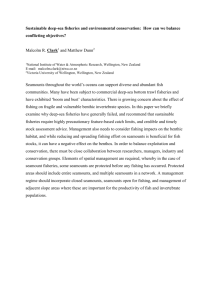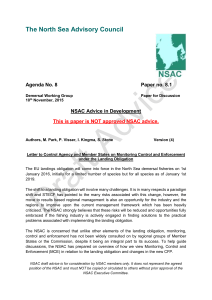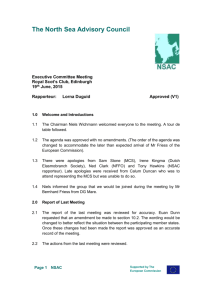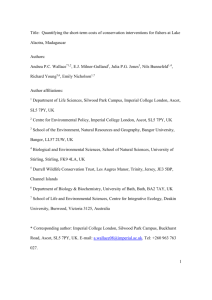Paper 4.1 Tech Reg Con (For App)
advertisement
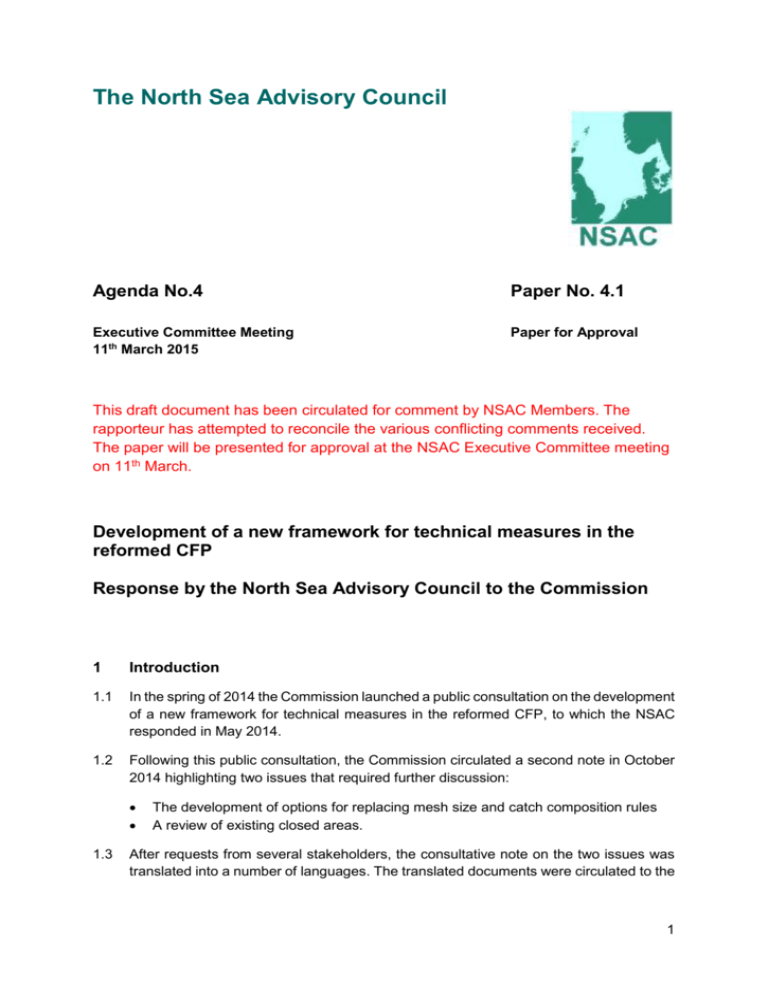
The North Sea Advisory Council Agenda No.4 Paper No. 4.1 Executive Committee Meeting 11th March 2015 Paper for Approval This draft document has been circulated for comment by NSAC Members. The rapporteur has attempted to reconcile the various conflicting comments received. The paper will be presented for approval at the NSAC Executive Committee meeting on 11th March. Development of a new framework for technical measures in the reformed CFP Response by the North Sea Advisory Council to the Commission 1 Introduction 1.1 In the spring of 2014 the Commission launched a public consultation on the development of a new framework for technical measures in the reformed CFP, to which the NSAC responded in May 2014. 1.2 Following this public consultation, the Commission circulated a second note in October 2014 highlighting two issues that required further discussion: 1.3 The development of options for replacing mesh size and catch composition rules A review of existing closed areas. After requests from several stakeholders, the consultative note on the two issues was translated into a number of languages. The translated documents were circulated to the 1 Advisory Councils at the beginning of January 2015. This paper presents the response of the North Sea Advisory Council (NSAC). 2 Development of options for replacing mesh size and catch composition rules 2.1 The Commission has stated that a new technical measures framework regulation is expected to contain: i. A limited number of general rules. ii. A section following the reformed CFP’s focus on results-based management in which objectives and targets would be set for technical measures. iii. The measures in a fishery/area required to meet the objectives and standards would be identified under regionalisation (Member States in consultation with stakeholders). 2.2 As stated in the NSAC response to the public hearing in 2014, the key to an effective set of technical conservation measures is to influence the mind-set of the person in the wheelhouse. That mind-set is often determined by economic factors in relation to the fishing gear used, or the fishing strategies adopted. The poor economic outcomes inadvertently created in the past by the imposition of poorly thought-out technical measures have often caused failure to meet the required objectives. 2.3 For the fisheries sector it is still questionable whether there is any requirement for a common EU framework regulation on technical measures. Those measures that do prove necessary should be decided on a regional level involving relevant stakeholders. The NGO and recreational angling representatives, however, believe that a number of minimum common standards for technical measures must remain within a common European framework. 2.4 The NSAC strongly supports the proposed move away from micromanagement and towards a results-based approach. Ideally, any measures that are necessary should be decided at a regional level in a relatively fast and efficient way in accordance with the basic regulation (e.g. Article 18(2)). Regional measures should be developed in consultation with the Advisory Councils: There is scope for technical measures to be tailored to specific fisheries at a regional level; through, for example, multi-annual plans. 2.5 Implementing a catch/results-based approach in fisheries would mean that there would be fewer requirements for input controls, and especially technical measures. The Commission has recently suggested the concept of output controls; working towards catch targets through clearly defined catch metrics and selectivity profiles. STECF has been asked to consider whether using catch metrics or selectivity profiles (or a combination of both) could be used as the basis of a results-based approach as an alternative to prescriptive gear-based or spatial measures. 2.6 A results-based approach requires baseline objectives to be defined. Monitoring is then required to determine whether those objectives have been reached. However, fishers 2 have emphasised that technical measures should not operate in a vacuum, but must be part of the overall conservation framework for the Common Fisheries Policy (which also follows from article 7 in the framework regulation 1830/2014). They have stressed that new objectives and conservations targets should not be set for technical measures in isolation, independent of the overall objectives for the Common Fisheries Policy. There is a risk of this happening with the introduction of catch metrics. 2.7 The Commission describes catch metrics as setting an output result; for instance a (maximum) proportion of the catch below the minimum conservation reference size (MCRS). For example, setting a limit of 20 individuals below the reference level per 10kg, or 10kg per 100kg (a proportion of the catch). The output could be measured per individual fishing trip or overall within a pre-defined management period/area. 2.8 Although such an approach may be appropriate for some fisheries, the Commission should be aware that there are risks in adopting such an approach. Introducing catch metrics would have a wider impact on national fisheries management. Furthermore, it is not at all clear how the introduction of catch metrics would affect the mind-set in the wheelhouse. The requirement for monitoring and documentation would create an additional burden for fishers. Pilot projects are needed to document the impacts and benefits of this type of measure before they are considered for implementation under the CFP. 2.9 The NSAC sees potential in the use of selectivity profiles for defining a baseline or default gear with a specific selectivity profile. This option means that fishers have the flexibility to develop alternative gears with demonstrated equivalent selectivity patterns in specific fisheries, differing from those specified in the regulations. This is something that is frequently requested by fishers, and this approach would be one that would be relatively simple for both administrators and fishers to work with. Of course, a “fast” procedure for “certifying” that a modification to a gear does not jeopardise the selectivity profile of the gear would be an essential part of the arrangement. 2.10 Having said this, a specific challenge here is to what degree this is an option at all for fishing vessels fishing in Norwegian waters – which is the case for many EU vessels in particular operating in the northern North Sea and the Skagerrak. So far EU vessels have been met with plenty of scepticism and even worse from the Norwegian authorities if any gear specification is not in accordance with Norwegian legislation. 3 Reviewing closed areas 3.1 At present the Technical Conservation Regulation includes a considerable number of closed and restricted areas for fisheries management purposes, along with closures established with the aim of protecting vulnerable marine ecosystems and supporting fish conservation. A review of those areas established under the CFP would contribute to simplification and rationalisation and would ensure that these areas correspond to clear conservation objectives based on the best available science. Marine ecosystems can be very dynamic and the particular fishes that live in an area may change with time. Closures and other measures protect juveniles, spawning adults or vulnerable species 3 need to be reviewed from time to time. In the worst cases restrictions may displace fishers, forcing them to fish in other areas that may themselves be in need of protection, thereby increasing fishing mortality. 3.2 The NSAC shares the view that the existing closed and restricted areas established through the CFP within the North Sea, the Skagerrak and the Kattegat should be reviewed to ensure that they have a sound conservation rationale and clear conservation objectives. Most of these areas were established some time ago and there is only limited documentation of their objectives, and limited information on the degree to which those objectives have been achieved. Such a review should of course take into account the impact that might be expected from reopening the area, or removing existing restrictions on fishing. 3.3 Even in the absence of clear scientific documentation it may sometimes make sense to establish temporal or spatial closures applicable to certain gears/fishing activities in certain habitats or targeting certain species. For reasons of legitimacy and to increase the effectiveness of potential measures, such closures should be developed on a regional basis, with input from relevant stakeholders. The CFP to some extent provides for this already, but the review of the technical measures framework could provide the opportunity to develop a regional management process to respond quickly to environmental changes (e.g. changes in the concentrations of juveniles) by being able to both adopt and remove spatial and/or temporal closures without going through the lengthy co-decision process. Transparent rules of procedures would of course be essential, together with close scientific monitoring and evaluation, both in the establishment of closures and in their removal. It would be relevant to incorporate provisions on Real Time Closures (RTCs) into this work as part of the multiannual plans. 4 In conclusion 4.1 Pilot projects should be encouraged for evaluating the impact of introducing catch metrics, selectivity profiles, and spatial measures. Fishers should also receive incentives and rewards for adopting conservation measures. Types of measures, and incentives to encourage their adoption, should be developed through discussions and decisions at a regional level, rather than through centralised co-decision; within an overall framework developed at the EU level. 4
